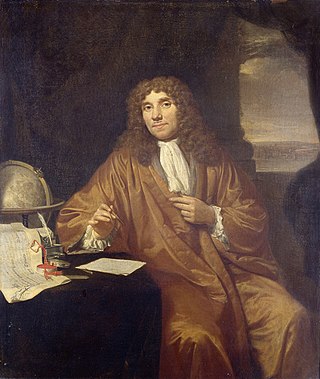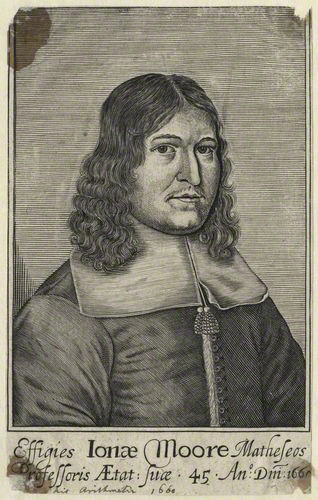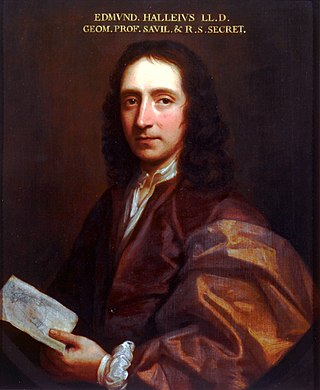Related Research Articles

Astronomer Royal is a senior post in the Royal Households of the United Kingdom. There are two officers, the senior being the astronomer royal dating from 22 June 1675; the junior is the astronomer royal for Scotland dating from 1834. The Astronomer Royal works to make observations to improve navigation, cartography, instrument design, and applications of geomagnetism. The position was created with the overall goal of discovering a way to determine longitude at sea when out of sight of land.

John Ray FRS was a Christian English naturalist widely regarded as one of the earliest of the English parson-naturalists. Until 1670, he wrote his name as John Wray. From then on, he used 'Ray', after "having ascertained that such had been the practice of his family before him". He published important works on botany, zoology, and natural theology. His classification of plants in his Historia Plantarum, was an important step towards modern taxonomy. Ray rejected the system of dichotomous division by which species were classified by repeated sub-division into groups according to a pre-conceived series of characteristics they have or have not, and instead classified plants according to similarities and differences that emerged from observation. He was among the first to attempt a biological definition for the concept of species, as "a group of morphologically similar organisms arising from a common ancestor". Another significant contribution to taxonomy was his division of plants into those with two seedling leaves (dicotyledons) or only one (monocotyledons), a division used in taxonomy today.

Antonie Philips van Leeuwenhoek was a Dutch microbiologist and microscopist in the Golden Age of Dutch science and technology. A largely self-taught man in science, he is commonly known as "the Father of Microbiology", and one of the first microscopists and microbiologists. Van Leeuwenhoek is best known for his pioneering work in microscopy and for his contributions toward the establishment of microbiology as a scientific discipline.

John Flamsteed was an English astronomer and the first Astronomer Royal. His main achievements were the preparation of a 3,000-star catalogue, Catalogus Britannicus, and a star atlas called Atlas Coelestis, both published posthumously. He also made the first recorded observations of Uranus, although he mistakenly catalogued it as a star, and he laid the foundation stone for the Royal Greenwich Observatory.

Robert Hooke was an English polymath who was active as a physicist, astronomer, geologist, meteorologist and architect. He is credited as one of the first scientists to investigate living things at microscopic scale in 1665, using a compound microscope that he designed. Hooke was an impoverished scientific inquirer in young adulthood who went on to become one of the most important scientists of his time. After the Great Fire of London in 1666, Hooke attained wealth and esteem by performing more than half of the property line surveys and assisting with the city's rapid reconstruction. Often vilified by writers in the centuries after his death, his reputation was restored at the end of the twentieth century and he has been called "England's Leonardo [da Vinci]".

Sir George Biddell Airy was an English mathematician and astronomer, as well as the Lucasian Professor of Mathematics from 1826 to 1828 and the seventh Astronomer Royal from 1835 to 1881. His many achievements include work on planetary orbits, measuring the mean density of the Earth, a method of solution of two-dimensional problems in solid mechanics and, in his role as Astronomer Royal, establishing Greenwich as the location of the prime meridian.
The year 1686 in science and technology involved some significant events.

Francis Willughby FRS was an English ornithologist, ichthyologist, mathematician and an early student of linguistics and games.
The year 1660 in science and technology involved some significant events.
The year 1675 in science and technology involved some significant events.
The year 1677 in science and technology involved some significant events.
The year 1683 in science and technology involved some significant events.
Events from the year 1675 in England.
Events from the year 1677 in England.
Events from the year 1676 in England.
Richard Towneley was an English mathematician, natural philosopher and astronomer, resident at Towneley Hall, near Burnley in Lancashire. His uncle was the antiquarian and mathematician Christopher Towneley (1604–1674).

Sir Jonas Moore, FRS (1617–1679) was an English mathematician, surveyor, ordnance officer, and patron of astronomy. He took part in two of the most ambitious English civil engineering projects of the 17th century: draining the Great Level of the Fens and building the Mole at Tangier. In later life, his wealth and influence as Surveyor-General of the Ordnance enabled him to become a patron and driving force behind the establishment of the Royal Observatory, Greenwich.

EdmondHalley was an English astronomer, mathematician and physicist. He was the second Astronomer Royal in Britain, succeeding John Flamsteed in 1720.

Paul Geoffrey Murdin is a British astronomer. He identified the first clear candidate for a black hole, Cygnus X-1, with his colleague Louise Webster.
References
- ↑ Chambers, R. (1878). The Book of Days.
- ↑ "How bacteria was discovered by the father of microbiology, Antonie van Leeuwenhoek". India Today. September 17, 2018. Retrieved 2021-08-30.
- ↑ Egerton, Frank N. (October 2005). "A History of the Ecological Sciences, Part 18: John Ray and His Associates Francis Willughby and William Derham" (PDF). Bulletin of the Ecological Society of America. 86 (4): 301–313. doi:10.1890/0012-9623(2005)86[301:ahotes]2.0.co;2 . Retrieved 2011-04-26.
- ↑ Keynes, Sir Geoffrey (1976). John Ray, 1627–1705: a bibliography 1660–1970. Amsterdam: Van Heusden. p. 52.
- ↑ Raven, Charles E. (1942). John Ray, naturalist: his life and works. Cambridge University Press.
- ↑ Newton, Alfred (1893). Dictionary of Birds. London: Black.
- ↑ Kaplan, Barbara Beigun (2004). "Briggs, William (c.1650–1704)". Oxford Dictionary of National Biography . Oxford University Press. doi:10.1093/ref:odnb/3413 . Retrieved 2011-10-10.(subscription or UK public library membership required)
- ↑ Sarjeant, William A.S. (1997). "The earliest discoveries". In Farlow, James O.; Brett-Surman, Michael K. (eds.). The Complete Dinosaur . Bloomington: Indiana University Press. pp. 3–11. ISBN 0-253-33349-0.
- ↑ The anagram is given in alphabetical order, ceiiinosssttuv, representing Ut tensio, sic vis – "As the extension, so the force": Petroski, Henry (1996). Invention by Design: How Engineers Get from Thought to Thing . Cambridge, MA: Harvard University Press. p. 11. ISBN 978-0674463684.